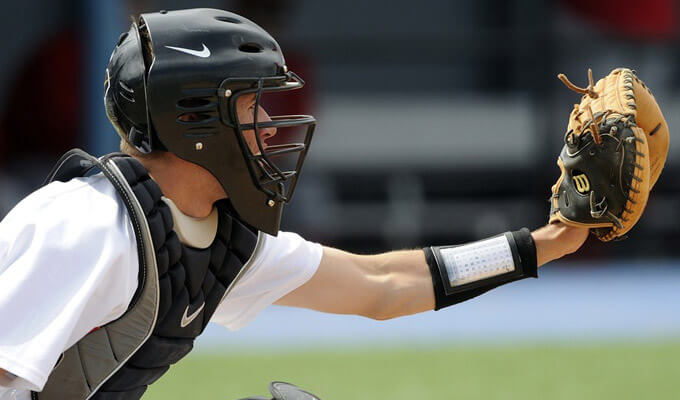Quick Navigation
Nike and their swoosh logo is one of the most recognized athletic brands in the word.
While it is typical to think of Nike in terms of their sneakers, especially the illustrious Jordan’s, the activewear apparel company also makes a fair amount of sporting equipment, including catcher’s gear for baseball.
Quick Look: Top 3 Picks
| IMAGE | PRODUCT | |
|---|---|---|
 | Best Catcher’s Chest Protectors
| VIEW LATEST PRICE → |
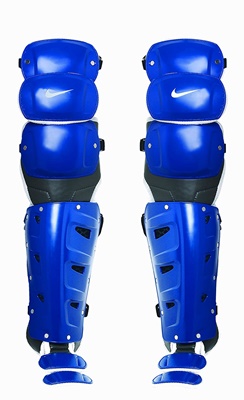 | Best Catcher’s Leg Guards
| VIEW LATEST PRICE → |
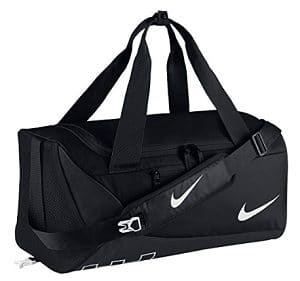 | Premium Choice
| VIEW LATEST PRICE → |
Despite facing tough competition from competing brands like Wilson, Mizuno, All-Star and many others, Nike’s catcher’s equipment is a yearly favorite among many players at all levels of play. Today, catcher’s gear is an essential set of equipment for playing behind home plate. The number two position faces a lot of painful hardships compared to other players, including close-range foul tips, rough collisions at the plate, errant bats and more.
The best catcher’s sets are those that blend together protectiveness with ease of motion, to allow for a quick pick off throw or a sliding stop on a wild pitch. However, there was a time in the early days of the game when catcher’s wore no equipment. In fact, when Roger Bresnahan became the first catcher to wear some protective guards, fans, teammates and opponents alike mocked him. Luckily, we’ve come along way from Bresnahan’s first, primitive set of catcher’s gear. Nike’s 2017 catcher’s gear pieces are full of impressive technologies that not only keep the player safe from the woes of the catcher’s position, but also aim to improve the player’s performance behind the plate. In this definitive buyer’s guide for Nike catcher’s gear, we’ll take a look at the individual pieces of equipment Nike has to offer (masks, gloves, leg guards and so on), but also some of the whole sets that the brand has available.
What To Look For In Catcher’s Gear
Despite what any review site says about a particular piece of catcher’s gear or set of equipment, one positive consumer experience doesn’t automatically mean you’ll have the same experience. One of the hardest things to measure is the actual fit of the gear. This is also one of the most crucial components to finding the best set of catcher’s gear for you. While every modern catcher’s set is adjustable and fits a wide range of body types, any veteran catcher can tell a horror story about a leg guard that rubbed behind their thigh the wrong way or a mask that never sat right on their face.
Thus, you should always, if possible, shop in person at a sporting goods store, as this creates the opportunity to try on any gear before making a final purchase. Past the fit of the gear, you want to consider how durable the equipment is going to be. In other words, how many games or seasons the gear will last before needing to be replaced. This is where product reviews do come in handy because real players will rate how durable they find the equipment to be, based on their own real-life experiences. Replacing any piece of equipment can be a problem for a player on a tight budget, which is why durability is such an important quality to think of when shopping for catcher’s gear. For a catcher, protective gear is almost a necessary evil; necessary because it protects them from otherwise dangerous projectiles, but evil because it inhibits the catcher’s range of motion.
The gear gets in the way of the natural motion the body takes when trying to make a tough catch in the dirt or gunning down a potential base stealer. The best pieces of catcher’s equipment are the ones that don’t limit this range of motion and allow the catcher the most freedom with their movements, without sacrificing the needed protection that this gear should deliver. Aside from fit, durability and range of motion, most pieces of Nike catcher’s gear have additional features and qualities that help them standout. That said, these are often seen as extra and not as necessary as the above traits. For example, some equipment leverages lightweight or mesh materials to improve breathability. While this certainly improves the player’s quality of life and comfort behind the plate, especially on a particularly hot day, it isn’t as necessary as a set of gear that fits right, lasts and doesn’t limit your ability to throw, catch and play.
Nike Catcher’s Masks and Headgear
At the top of the catcher’s protective arsenal is the catcher’s mask. In its earliest forms, the catcher’s mask resembled more of a bird cage or medieval torture device, but today’s masks are sleek, sophisticated pieces of equipment that are specially engineered to provide the catcher with optimal protection and the widest field of view. While protection should be the forefront of any mask’s design (after all, it is protecting your head!), the mask itself and how much it allows you to see is also crucial.
Different masks will configure the metal caging that protects the face in different ways, in order to try and improve the player’s ability to survey the field and make accurate throws Fit, in terms of a catcher’s mask, is extra important. When a throw needs to be made to pick off a runner or a ball is popped up behind the plate, the majority of catchers will remove their mask and headgear, to ensure that none of their vision is obstructed. This means that a catcher’s mask has to both fit snugly on the player’s head, but also be able to come off at a moment’s notice. This can be a hard balance to achieve. For 2017, Nike’s top pieces of headgear for catchers are the DE3539 and the Facemask/ Field Helmet combination.
Nike Catcher’s Facemask and Field Cap
Whereas the DE3539 has a hockey-inspired design to it, this piece of equipment follows the more traditional approach to catcher’s headgear by keeping the mask and helmet as two separate pieces. While this sacrifices some of the protection that you get through a fully enclosed helmet, the mask and skullcap combination is much easier to remove on the fly and the player’s peripheral vision is much better compared to the hockey-style helmets. The Nike Catcher’s Facemask is much lighter than most catcher’s headgear. Again, this contributes to this equipment’s ability to be easily removed. The mask has energy absorbing foam on the interior, which can be removed as needed to deliver a more customized fit on the face.
The foam material helps improve protection and keeps dry thanks to a wicking cover. To protect the lower part of the face and neck, the wire of the mask extends down to the throat. The Nike Field Cap has the same ABS outer shell as the DE3539. There is three layers of padding on the inside of the cap, including an EVA inner layer that is specifically designed for impact absorption, while the other layers add for comfort and moisture wicking. The top of the helmet has ventilation holes for superior airflow and a cooler head. Both the facemask and field cap are adjustable and ‘one size fits most.’ The mask is only available in black, but the field cap can be purchased as black, red, navy or royal blue. These two pieces of equipment are sold separately, but the total cost is competitive and not too expensive.
Pros:
- Classic, two-piece design that is easy to remove quickly
- Field Cap offers three layers of padding, for both comfort and protection
- Facemask protects all the way down to the throat and gives the catcher a good field of vision
Cons:
- Each piece is sold individually
- Not as protective as fully-enclosed helmets
- Facemask is only available in a single color
Even today, a lot of catcher’s swear by the traditional, two-piece mask and helmet combinations. They may lack some of the protection of other catcher’s headgear, but they are easy to remove and offer some of the best visibility of any competing equipment. The combined price of both the facemask and the field cap is close to what you would pay for the Nike DE3539.
Nike Catcher’s Chest Protectors
One of the unique concerns that a catcher has about choosing the right chest protector is how effective it is at dampening the energy of the ball. Catchers routinely have to block balls with their chests, whether it is a ball that passes by the defense of their glove, or a wild pitch. When runners are on base and threatening to steal, a pitch bouncing a few feet away from the catcher can be the difference between an out and a stolen base.
That’s why the padding of a catcher’s chest protector has to be engineered to protect the player and kill the energy in the pitched ball to keep it in reach of the catcher. The other important trait of a chest protector is how much, or how little, it limits the catcher’s range of motion, specifically with his or her throwing arm. Many chest protectors have shoulder guards attached, which are good in terms of protecting the body, but some of the bulkier chest guards can limit the player’s throwing capabilities. Two of Nike’s best chest protectors for 2017 are the DE3539 Catcher’s Chest Protector and the Pro Gold Precision Chest Protector.
Nike DE3539 Catcher’s Chest Protector
The engineers at Nike behind the DE3539’s chest protector spared nothing. The foundation of this piece of equipment is its multiple layers of high-quality, lightweight foam padding. Each layer of this Dual Density Energy Arrest padding is designed to dampen the energy of the ball, thereby keeping it closer to the catcher on pitches that take a bad hop or need to be blocked. In addition, the ergonomic harness not only gives the catcher a comfortable form-fit, but thanks to the Control Flex design, it also conforms and flexes as the catcher’s body does so. This has a big impact on his or her ability to control a blocked ball and keep it close by. The Control Flex design and Dual Density Energy Arresting padding combine to make one of the best chest protectors out there at keeping the ball close and immediately playable.
Aside from dampening ball energy, the DE3539 Catcher’s Chest Protector has other features that make it a high performance piece of equipment. One of its four layers of padding is actually crafted to make the chest plate more breathable. The layer has a diamond-shaped pattern that vents out hot, stale, sweaty air and replaces it with cool, breathable air. Comfort behind the plate can be an often overlooked aspect, but, on a hot day, the one feature that may elevate a player’s performance is these vents because they limit the potential fatigue of the player. Similar to the DE3539 Catcher’s Helmet, this chest protector is available in four colors: black, navy, royal blue and red. It has detachable shoulder pads, which allow the player to decide if they want the protection or better freedom of motion. When you consider all of its incredible features and design, the price point is very competitive for the Nike DE3539 Catcher’s Chest Protector.
Pros:
- One of the best chest protectors at dampening the energy of blocked or deflected balls
- Comfortable and sturdy to wear; doesn’t require the player to constantly readjust
- Ventilation keeps player cool on hot days
- Removable shoulder pads to fit different catchers preferences
Cons:
- Mid-to-high price range
- Only available in Adult and Intermediate sizes, no youth size
It is very difficult to find fault in the Nike DE3539 Catcher’s Chest Protector. Its incredible ability to keep the ball close at all times is hard to beat, even by the best chest guards made by Easton, Mizuno and other top competitors. Unfortunately, this high performance capability does raise the price of this product by a little bit. That said, its features can directly help improve a catcher’s level of play, while also making their job a little easier behind the plate.
Nike Pro Gold Precision Chest Protector
As the predecessor to the DE3539, the Nike Pro Gold Precision Chest Protector has a lot of the same features and design elements. For example, it uses the same Control Flex design and layered Dual-Density Energy Arrest pads to dampen the energy of pass balls. Although, it doesn’t use quite as many layers as the DE3539. This older model chest guard was popular by some of the Big Leagues top catcher’s, including Russell Martin, Joe Mauer and Jorge Posada. Martin, in particular, was known for wearing the Pro Gold without the detachable shoulder guards, to free up his arm and improve his range of motion when gunning down a runner.

The older Pro Gold Precision uses a hex-patterned ventilation system, instead of the diamond-shaped vents of the DE3539. It isn’t entirely clear what the advantage of one system over the other is. Although, it would stand to reason that the newer model chest protector has the more advanced and well-engineered cooling system. Additionally, the Pro Gold uses a different harness. This full-suspension equipage maintains a comfortable fit all game long, but it isn’t quite as form-fitting as the newer harness in the DE3539.
Pros:
- Equal energy dampening ability as its successor, the DE3539
- Hex-Vent padding helps keep the player cool and sweat-free
- Worn and approved by some of the game’s best catchers
- More affordable than many other options
Cons:
- Compared to the DE3539, the Pro Gold Precision lacks the same comfortable, form-fit design of the harness system
- As an older model chest protector, it may be difficult to find in your local sporting goods store
Even though the Nike Pro Gold Precision Chest Protector is an older model that is eclipsed by the newer DE3539, the world of catcher’s chest protectors doesn’t move all that fast, which means that there isn’t isn’t much different between these two. They both have the same features to help control and corral balls taken off the chest. They have virtually the same ventilation system. The only real differences are the type of harness and the price. If the harness of the Nike Pro Gold doesn’t bother you or cause any discomfort, and you want to save a few bucks compared to the DE3539, then it is a great option.
Nike Catcher’s Leg Guards
The most important characteristics of a catcher’s leg guards are fit and comfortability. Any catcher knows how grueling it can be to stay squatted for all nine innings. Thus, their leg guards need to provide the necessary support and comfort needed to make this task a little less strenuous. Aside from the catcher’s comfort, the fit of their leg guards is also important to enhance their mobility. Catching a baserunner trying to swipe a bag requires the catcher to be able to pop up quickly and make a solid, accurate throw. This means their leg protectors need to be lightweight and not limit the player’s ability to move swiftly.
Mobility is also important for tracking down pop flys behind the plate. The last important task that rests on the quality of the catcher’s leg guards is the means to slide to either side or drop down quickly to stop balls in the dirt. While the primary objective is to stop balls with the chest (or better yet, the mitt), this isn’t always possible, especially on a wild pitch. Sometimes, the catcher has to stretch out to either side and use their legs to prevent the ball from escaping their defense and reaching the backstop. The catcher’s leg guards need to permit the player to extend their defensive perimeter to all sides and parts of the plate’s backyard with ease and timeliness. The best available leg guards offered by Nike are the new DE3539 Leg Guards.
Nike DE3539 Leg Guards
Nike has certainly studied the woes of catcher’s and their leg guards and aimed to solve as many of these grievances as possible with the DE3539 Leg Guards. Despite the triple-knee feature, which provides optimal protection to the knees and thighs, Nike aimed to design these leg guards after the natural, anatomical structure of the player’s legs. This creates an enhanced, form-fit that makes movement come easy. Nike took the fit of their leg protectors a step further, by introducing a calf harness system inside the gear.
For protection and durability, Nike reinforced the parts of their leg protectors that take the most abuse. Even though the catcher’s leg guards don’t take as much damage from errant balls, bats and other projectiles as the mask or chest protector do, they do spend the most time in the dirt. To be able to last all season long and beyond, the leg guards need to be durable enough to withstand the dirt and grime. The last feature of the DE3539 Leg Guards is the diamond vent padding which allows for better cool airflow. Like the rest of the DE3539 set, these leg guards are available in black, red, navy and royal blue.
Pros:
- Made to fit the natural curves and movements of the player’s legs
- Ultra durable to withstand any damages from balls, collisions or getting down in the dirt
- Ventilates in cool air to keep the player cool and resistant to fatigue and heat exhaustion
Cons:
- Only available in certain sizes
- Brighter colors (royal blue, red) show wear from dirt very easily
The Nike DE3539 Leg Guards display all of the qualities of a high-quality pair of leg protectors. They are not only protective, but also cause very little restriction of movement, which means the catcher can perform his or her duties much better, whether they are trying to stop a ball in the dirt, range to catch a pop fly or toss out a baserunner attempting to steal.
Nike Catcher’s Mitt
Pitcher’s throw hard and fast. Even the slowest pitches at the top levels of play are coming in no slower than 75 MPH. To protect the catcher’s hand from the repeated wallop of high-nineties fastballs, the mitt of this player has to be extra padded. The mattress-style mitt that a catcher wears has to be thick enough to protect their hand, but also flexible enough to open wide and scoop a ball pitched in the dirt.
The depth of the mitt’s pocket is a major consideration for catchers. When a baserunner takes off to steal a base, the catcher has only a small window of time to receive the ball from the pitcher, stand, transfer the ball from mitt to hand and make the throw. The time it takes the player to complete this sequence of actions is referred to as the pop time. Catchers prefer a shallow pocket because it hastens the process of transferring the ball to their throwing hand and improves their pop time. Nike hasn’t released a new catcher’s mitt in some time. However, their last glove, the N1 Air Series (BF1357) can still be found online and in some sporting goods retail stores.
Nike N1 Air Series Catcher’s Mitt
The Nike N1 Air Series is a catcher’s mitt that is built to last. The mitt has reinforced anti-abrasion edges, which prevent it from becoming torn and worn out from heavy impacts and digging for balls in the dirt. Constructed with oil-rubbed steer hide for added durability, the N1 glove maintains its shape and strength longer.
To negate the sting of fastballs, Nike implemented their Air Bag technology. This feature produces a slight curve in how the player’s upper palm and index finger fit into the leather, which creates ‘no-sting impact control.’
The pocket of the glove is shallow and provides that quick transfer time to prevent stolen bases. The oil rubbing process that the steer hide undergoes makes the leather exceptionally soft and comfortable on the hand. The N1 Air Series catcher’s mitt utilizes the NikeFIT DRY fabric linings to wick sweat away from the player’s hand and fingers.
Pros:
- Prevents ball sting felt by the palm and fingers
- Comfortable, durable and adequately priced
- Shallow pocket for quicker pop time
Cons:
- Discontinued product that may be difficult to find
- Requires a significant break in period to get loose and game-ready
Overall, the Nike N1 Air Series catcher’s glove offers a lot of much needed amenities to catchers. Even though the mitt is older and may be hard to find, it competes with many of the brand-new catcher’s gloves being produced today. The main drawback of this product is its immediate stiffness that takes some time to loosen up.
Bringing It All Together: Nike Catcher Sets and Equipment Bags
For a more uniform and complete look, catchers typically buy their equipment as a set. Catcher’s sets are also a more convenient and affordable option than individually purchasing each piece. The only complete set that is currently offered by Nike is the DE3539, which has been described separately in each of the above sections. As a set, the DE3539 series is a little more affordable than some of the offerings by Mizuno, Easton and other major competitors. Yet, it hits a lot of check marks on any catcher’s shopping list.
The chest protector helps keep the ball in front of the catcher, the leg guards don’t limit his or her ability to move and react swiftly and the helmet provides a clear field of view. With all their extra gear, catcher’s often need an equipment bag to haul this extra load. Nike offers a lot of options when it comes to equipment bags. Their larger bags, like the Nike MVP Elite Roller and Fuse Bag can carry the player’s extra protective equipment and multiple bats and other stuff they may need for game time.
NIKE Brasilia Duffel Bag
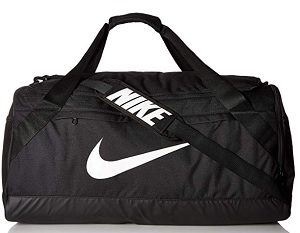
Nike Alpha Adapt

The Brasilia and Alpha Adapt bags are slightly smaller (and cheaper), but still have plenty of room for a catcher’s gear.
NIKE Brasilia Duffel Bag
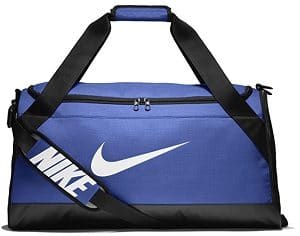
Nike Alpha Adapt

Going smaller than that, Nike has backpack-style equipment bags, but many of these may be too small to comfortably pack a full set of catcher’s equipment into.
Final Conclusions
The purpose of this guide was mainly to discuss and review the popular catcher’s equipment offered by the Nike brand. Hopefully, however, you also learned something about shopping for catcher’s gear in general, such as what qualities and characteristics to look for and which to avoid. If you are in the market for new catcher’s equipment for you, a family member or a friend, you now have the knowledge to find the ideal set for an appropriate price.


